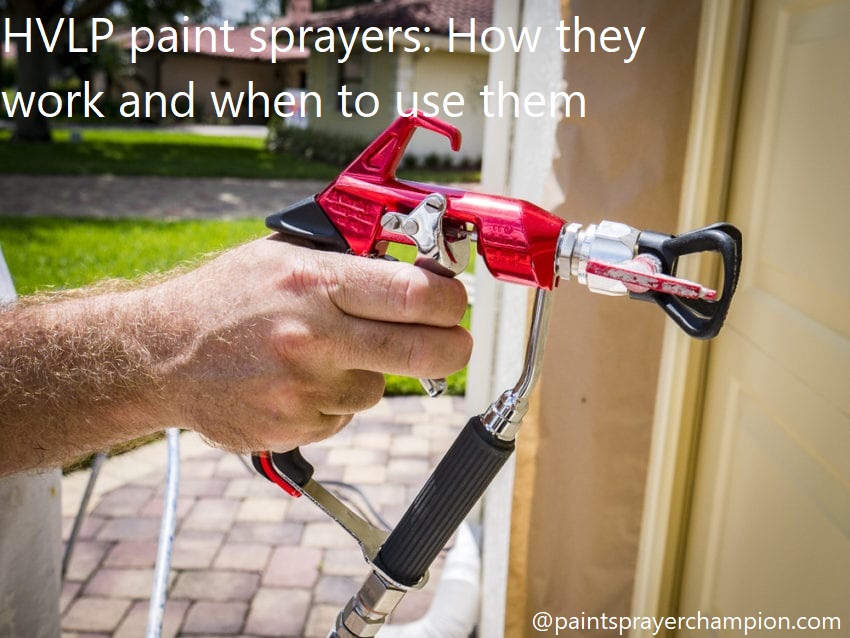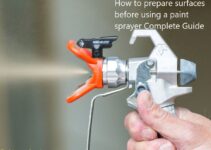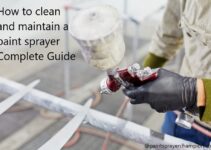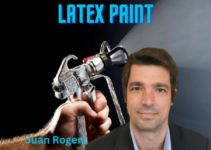Have you ever wondered how a HVLP paint sprayer works? Or maybe you’ve been considering using one but aren’t sure where to start?
In this article, we’ll discuss the inner workings of HVLP paint sprayers and when they are most suitable for use. You’ll be an expert in no time!
HVLP (High Volume, Low Pressure) paint sprayers are among the most popular and reliable tools for applying paint, coating, varnish, and lacquer to surfaces. Unlike traditional airless sprayers that create a fine mist of paint droplets at high pressure – which can result in wasted product and mess – HVLP sprayers use low pressure to create a soft, wide cone of mist that is better suited for precision work. In this guide we will demonstrate how HVLP paint sprayers work and when they should be used.
Definition of HVLP paint sprayers
HVLP (High Volume Low Pressure) paint sprayers use a high volume of air to atomize a small amount of paint, giving you better control and fewer leaks. The way the air is fed into the nozzle creates a fine mist that almost looks like foam, which helps guide the color onto your project surface in an even layer. This produces a much smoother finish than brush painting, with less risk of running or flaking.
HVLP sprayers are great for painting large surfaces quickly and easily, such as furniture, walls, cabinets and decks. They’re especially good for detailed work since they are easier to control than brushes or rollers. HVLP sprayers are also relatively low in cost compared to other types of paint application equipment. Plus, their versatility makes them suitable for both indoor and outdoor use when applying paints or sealants.

Importance of using HVLP paint sprayers
High Volume Low Pressure (HVLP) paint sprayers provide a superior level of control and precision, making them the go-to choice for all kinds of DIY projects. With HVLP, you don’t have to worry about overspray or uneven coverage — it’s much easier to apply a consistent finish. They also require less material to do the job, which means they use fewer resources and are more cost-effective — all while producing a high quality look!
Whether you’re painting furniture or walls, staining an outdoor deck or fence, refinishing cabinets or applying protective sealant on hardwood floors — HVLP is the perfect tool for getting the job done quickly and effectively. Whether you choose an airless paint sprayer (HVLP), electric paint sprayer (HVLP), conventional spray gun (HVLP) or hand-held aerosol can – there are many benefits to using an HVLP paint sprayer when completing your next project.
One advantage of using an HVLP is that it uses less material than traditional methods like brushes and rollers. This makes them more efficient because less paint is used in each application. Additionally, since less air escapes around the painting object when using an HVLP because its nozzle generates small low pressure droplets capable of coating both your intended surface as well as hard-to-reach areas like corners with one coat coverage. This also means that extra coats of paint will not be necessary throughout your DIY project – lowering overall costs as well as time spent applying finishes to various surfaces! Finally with minimal overspray produced during application processes clean up becomes much quicker without having to worry about inadvertently ruining any adjoining surfaces!
Overview of what the guide will cover
This guide will cover the fundamentals of understanding how HVLP (High Volume, Low Pressure) paint sprayers work, as well as when and why you should use them for your next painting project.
It will explain how HVLP sprayers utilize air pressure to atomize paint into fine particles, resulting in a smoother finish than traditional brush or roller methods. Additionally, this guide will discuss the types of materials that can benefit from using an HVLP system such as furniture, interior/exterior walls, cabinets, trim and more.
Furthermore, it will provide a list of key criteria to looking for when shopping for a quality HVLP system. Finally, the guide will also include installation advice as well best practices when utilizing an HVLP sprayer to get the best possible results with minimal time and effort spent prepping the surface or cleaning up afterwards.
How HVLP Paint Sprayers Work
High Volume Low Pressure (HVLP) paint sprayers are used to reduce overspray and achieve greater efficiency when applying a finish on any type of surface. This type of sprayer uses a low-pressure system to deliver the same amount of material at a fraction of the air pressure, resulting in precise coverage with less mess and fewer risks.
HVLP paint sprayers make use of two main components, an atomizing turbine, and an uninterrupted fluid flow nozzle. The turbine converts electrical energy into rotary motion that propels the material in small particles through the spray gun. The nozzle maintains a steady rate of fluid flow for consistent coverage and a uniform finish.
When using HVLP paint sprayers, it is important to make sure that the air pressure setting is matched to the type of material being sprayed; otherwise it could lead to inadequate coverage or an uneven-looking surface. Additionally, regular maintenance is essential for keeping this equipment in good working condition and extending its life span significantly.
Explanation of HVLP technology
HVLP, or High Volume Low Pressure technology, is a relatively new system for painting surfaces. It has become increasingly popular since the 1990s, with both hobbyists and professionals taking advantage of its balanced application of paint to provide superior control and a smoother finish. HVLP systems are available in both portable turbine systems and can be found in spray equipment.
To understand how HVLP works, it’s important to understand the differences between conventional low pressure (or LP) systems and HVLP technology. In conventional LP systems, air is pressurized by a nozzle to increase atomization while paint is added at low pressure. This creates the high spray volume but often results in an uneven finish due to improper atomization. The problem of atomization can be further exasperated if the painter tries to achieve yields beyond what the equipment will tolerate.
In contrast with LP technology, HVLP applies a lower transfer efficiency which allows for better control with fewer problems from splatter or overspray as it relies on much less compressed air than other technologies allowing for precise atomizing patterns to be formed. The total amount of material applied per square inch is reduced meaning you get more coverage per gallon while saving on material costs over time as well as reducing VOC emissions into the atmosphere which makes it much friendlier than traditional techniques when painting large areas or intricate surfaces like furniture refinishing. Additionally, HVLP can be used in areas where higher powered equipment would not pass regulations like hospitals or museums due its lower noise levels versus other technologies making it ideal for those sensitive spaces without sacrificing performance or finish quality.
Components of an HVLP paint sprayer
HVLP, or High Volume Low Pressure, paint sprayers are the preferred choice for most professional and DIY painters due to their low overspray and greater efficiency compared to conventional spray guns. Paint typically sprays out of a nozzle held in the material cup connected to the paint reservoir. This sends a high volume of paint particles at a lower pressure than other traditional spray systems.
Common components of an HVLP system include:
– Sprayer – A motorized device with air controls that directs air streams through tubing. This powers the nozzle where jets of paint emerge when the trigger is pressed. – Gun/Nozzle – The gun is composed of a number of parts including the nozzle holder, air valve, air regulator, and spray hose all working together to control paint output from the gun. – Cup/Reservoir – A canister attached to the underside of the gun that holds and dispenses paint from it’s spout or pour hole when a trigger is pulled or released. This can vary in size depending on your project needs. – Air Compressor – A machine capable of producing and maintaining compressed air for use with HVLP systems; these vary in sizes from large stationary units to portable wheeled compressors perfect for taking out into the field or onto large commercial jobs like warehouses or other large buildings – Air Filter – An inline filter typically located near where hose connects to your compressor; this helps remove dust and dirt prior by filtering out contaminates before they enter your setup.
How the sprayer delivers paint
High Volume Low Pressure (HVLP) paint sprayers use a high volume of air to push a low pressure mist of paint directly onto a surface. This type of sprayer is advantageous because it helps reduce the amount of material that is wasted—unlike conventional spraying processes, where most of the paint ends up on the floor and walls. The HVLP process results in less overspray and better atomization, which equates to an even, consistent coating.
The technology works by using a specialized turbine or motor attached to the air intake valve. As air pushes through this valve, it is directed into the nozzle where an adjustable fan pattern sprays out the paint. This fan pattern can be adjusted to accommodate various job sizes which increases the efficiency and offers more flexibility for various surfaces.
When deciding whether or not to use an HVLP spray gun for a project, it helps to evaluate how much time will be spent on preparation compared to painting. If there’s not enough time for proper preparation, then using a brush or roller may be more effective as you’ll have less overspray due to bad technique or inferior equipment than if you had used an HVLP gun. Additionally, factors such as material cost and drying time should also be taken into consideration before investing in any specific tool or piece of equipment.

Advantages of HVLP Paint Sprayers
HVLP paint sprayers offer several advantages over traditional spraying techniques. The major benefits include better atomization, superior control, less material wastage and a better finish. With an HVLP unit, the atomized particles are much finer and more consistent than those produced with a conventional unit. While both use compressed air to move material through the nozzle, HVLP units also utilize gravity-fed cups or reservoirs which feed the product directly into the air stream. This ensures that only a small amount of material is exposed to air pressure at any given time, resulting in more efficient transfer of material from cup to surface.
The superior control that comes with using an HVLP unit allows for smooth transitions and even coverage across larger surfaces without the need for additional coats. Additionally, it’s easy to adjust the pressure on these models which gives you much more control over how much product you dispense per coat. This eliminates overspray and provides superior coverage while significantly reducing any potential wastage as well as clean up time afterwards. Finally, an HVLP shooter will be able to provide a professional-quality finish due to its ability to atomize materials into smaller particles which can dry quickly and evenly on most surfaces creating a smooth and consistent look.
Higher transfer efficiency
High volume, low pressure (HVLP) paint sprayers are an advanced technology which provides much greater transfer efficiency than conventional sprayers. This improved transfer efficiency means that less paint is lost in the air, leading to a much more efficient workflow and reduced material and labor costs. HVLP sprayers also provide a smoother, even finish compared to traditional spraying methods.
This increased efficiency is due to the design of HVLP paint sprayers, which use a compressor to produce high pressure air which is then fed into the gun at a regulated pressure level. This increases the atomization of the paint particles, reducing overspray and providing better coverage. The pressure must be regulated carefully in order to remain consistent throughout each job; this often requires an adjustable knob on the gun itself or using manual valves to adjust flow rate as needed.
The improved transfer efficiency offered by HVLP painting allows for faster work times and greater accuracy when painting over large surfaces or complex shapes. Additionally, environmental regulations often require the use of HVLP technology due to its reduced emissions of volatile organic compounds (VOCs). Furthermore, it can be used for both solvent-based and water-based coatings – making it suitable for almost any kind of painting job.
Reduced overspray
One of the main benefits of using an HVLP paint sprayer is the reduced overspray. This occurs when a high-efficiency turbine produces air at a much lower pressure (average of 10 psi) than regular airless sprayers (up to 3,000 psi). The lower pressure allows the even dispersion of droplets, creating a finer and more consistent paint finish that results in fewer lost particles.
The other advantage to using HVLP paint sprayers is their efficient use of paint. Because they produce a fine mist and spray pattern, more paint coverage can be achieved with less product. This ultimately saves time and money when it comes to completing large projects with intricate detail work. The focused pattern also helps reduce the risk of overspray on adjacent surfaces and reduces the amount of clean-up needed after each job.
Finally, HVLP paint sprayers come in many different sizes so they can be used on any surface ranging from small furniture to walls in large buildings. With all their positive attributes, plus the potential for reduced waste and cleanup time, these lightweight tools are popular among do-it-yourself painters and professionals alike!
Better control and precision
High Volume Low Pressure (HVLP) paint sprayers are specialty tools that offer a high degree of control over the painting process. They provide much greater accuracy than other types of paint sprayers, allowing users to apply coatings in even layers with minimal overspray and almost no waste. In addition, HVLP systems feature adjustable fan patterns and pressures for laying down very thin layers or thicker coats. This makes them ideal for jobs that require precision and attention to detail.
In order to achieve its exacting results, an HVLP system works differently from its peers. Instead of using a high-pressure compressor like conventional airless sprayers, these tools employ suction from an air turbine or compressor to draw paint into the gun at low-pressure levels—usually in the range of about 10 psi. The material then exits the gun via a small nozzle, at which point it’s applied with an airflow that is regulated by controlling the speed of the turbine or compressor fan blade. This method is not only more accurate than others; it’s also significantly quieter and requires less energy to run than many other types of sprayers.
An HVLP system is perfect for such tasks as refinishing furniture, painting ceilings and walls in fine detail, and staining decks or fences. It can also be used to apply membrane coatings on metal roofs or commercial buildings since thin layers help ensure even coverage without leaving any waste behind. Thanks to their accuracy and precision control, HVLP systems have become an invaluable tool in industries ranging from aerospace manufacturing to automotive detailing—and everything in between!
Reduced air pollution
Using HVLP (high volume low pressure) paint sprayers is advantageous for both home and industrial purposes because these types of sprayers can minimize overspray, thereby reducing air pollution.
Thanks to its lower pressure levels, HVLP systems also generally require less energy compared to other traditional spray systems. Therefore, painting projects become more energy-efficient and cost-effective due to the reduced amount of material used.
Since the atomization process is much more precise with an HVLP system, far less material ends up as waste in comparison with conventional paint guns.
Another advantage of having reduced air pollution relates to sound levels: the lower air pressures required in an HVLP system reduce operation noise and drastically aid in noise abatement over wide areas. Likewise dust creation and airborne particles in the vicinity of a job site are lowered when using this type of paint spraying technology since most overspray sticks directly onto targeted surfaces and not into the atmosphere.

Conclusion
In summary, HVLP paint sprayers are a good option for painting projects that require professional results without breaking the bank. They are easy to use, require less preparation than traditional brush or roller painting, and can be used on a wide range of surfaces with even coverage.
Furthermore, there is no need for high-pressure tanks since the motorized turbine does the job of delivering the paint under precise control. Depending on your application, you can choose between an LVHP or HVLP sprayer for any type of indoor or outdoor painting project.
If you’re looking for an efficient and cost-effective way to get a professional finish on your next job, an HVLP paint sprayer may be just what you need!
FAQ’S
How do you paint with a HVLP sprayer?
To paint with a HVLP sprayer, fill the cup with paint, adjust the air pressure, test the spray pattern, and then spray the object using even strokes.
When should you use a paint sprayer?
A paint sprayer should be used when you have a large surface area to cover, need a smooth finish, or need to get into tight spaces that a brush or roller can’t reach.
What are the advantages and disadvantages of HVLP spray gun?
Advantages of HVLP spray guns include less overspray, finer atomization, and reduced paint waste. Disadvantages include slower application time and the need for a separate air compressor.
Can you spray regular paint in HVLP?
Yes, you can spray regular paint in a HVLP sprayer, but you may need to thin the paint and use the correct nozzle size to achieve the desired finish.
What type of paint is best for HVLP?
Water-based paints and thin coatings are generally best for HVLP spray guns. However, some oil-based paints can also be used if properly thinned.
What is a HVLP sprayer used for?
A HVLP sprayer is used for a variety of painting projects, including furniture, cabinets, walls, ceilings, and automobiles.
Can you paint a car with a HVLP sprayer?
Yes, you can paint a car with a HVLP sprayer, but it requires proper preparation, technique, and the correct equipment and materials.
What are the benefits of a paint sprayer?
Benefits of a paint sprayer include faster application, smoother finish, less physical strain, and the ability to reach tight spaces.
Is spraying better than painting?
Spraying is better than painting in certain situations, such as when you need to cover large surface areas quickly and achieve a smooth finish. However, brushing or rolling may be more appropriate for smaller projects or when precision is required.
Which is better HVLP or airless?
The choice between HVLP and airless spray guns depends on the project and type of coating. HVLP spray guns are generally better for thinner coatings and indoor projects, while airless spray guns are better for thicker coatings and outdoor projects.
See Also:
- Best paint sprayer for exterior house
- Best paint sprayer for ceiling
- Best paint sprayer for cars
- Best handheld paint sprayer
- Best hvlp paint sprayer


